Introduction: You and the Arts
Cool. But … let’s explore that. For example, do you like poetry? No? What about song lyrics? Do you ever sing favorite lyrics because they move you? Well, that’s poetry, Lyric Poetry:
Lyric Poem
a relatively short poem which expresses the deep reflections and poignant emotions of the poetic voice: e.g. sonnet, ode, elegy. Origin: the portion of ancient Greek dramas sung to the accompaniment of a lyre (harp)
This definition applies to the “words” of popular songs today. We inherit the term from Greek playwrights (e.g., Aeschylus, Sophocles, Aristophanes) who, five centuries before Christ, dramatized stories from their mythology. The lyric portions of these plays were accompanied by the lyre (a stringed instrument similar to a harp). In the Euro-American literary tradition, lyric is applied to “the sonnet, ode, and elegy, along with many other varieties deriving from popular song.”
Martin Luther: A Mighty Fortress is Our God
One lyrical Genre is the hymn. Let’s explore a Protestant standard.
Martin Luther. A Mighty Fortress is Our God (Lyrics and Audio file)
- A mighty Fortress is our God,
a Bulwark never failing;
Our Helper He amid the flood
of mortal ills prevailing:
For still our ancient foe
doth seek to work us woe;
His craft and power are great,
and armed with cruel hate,
On earth is not his equal. - Did we in our own strength confide,
Our striving would be losing;
Were not the right Man on our side,
The Man of God’s own choosing:
Dost ask who that may be?
Christ Jesus, it is He;
Lord Sabaoth His Name,
From age to age the same,
And He must win the battle. - And though this world, with devils filled,
Should threaten to undo us,
We will not fear, for God hath willed
His truth to triumph through us:
The Prince of Darkness grim,
We tremble not for him;
His rage we can endure,
For lo! his doom is sure,
One little word shall fell him. - That word above all earthly powers,
No thanks to them, abideth;
The Spirit and the gifts are ours
Through Him who with us sideth:
Let goods and kindred go,
This mortal life also;
The body they may kill:
God’s truth abideth still,
His Kingdom is forever.
Translated by F. H. Hedges.
This hymn is a favorite for Protestant worshipers. But the more we know of the Context of its composition, the more we appreciate the lyrics. The hymn was one of many written by the 16th Century monk and scholar Martin Luther who braved the wrath of the Roman Church to challenge Papal authority. In 1521, Luther confronted the Holy Roman Emperor and papal representatives to defend his ideas. He was condemned to excommunication and death. Yet God led him to sanctuary in a “mighty fortress,” Wartburg Castle, owned by Frederick III of Saxony. Think of that place of sanctuary when you hear or sing this hymn.
Woody Guthrie: This Land is Your Land
As do residents of every country, Americans are inspired by songs celebrating their nation. Listening to Woody Guthrie’s This Land is Your Land (1940), many Americans celebrate the magnificence of their national landscape.
Woody Guthrie. (1940) This Land is Your Land
- This land is your land, this land is my land
From California to the New York island,
From the redwood forest to the Gulf Stream waters;
This land was made for you and me. - As I was walking that ribbon of highway
I saw above me that endless skyway;
I saw below me that golden valley;
This land was made for you and me. - I’ve roamed and rambled and I followed my footsteps
To the sparkling sands of her diamond deserts;
And all around me a voice was sounding;
This land was made for you and me. - When the sun came shining, and I was strolling,
And the wheat fields waving and the dust clouds rolling,
As the fog was lifting a voice was chanting:
This land was made for you and me.
Listen to Woody Guthrie’s performance of his song: link.
Do you dislike “poetry” but enjoy song lyrics? Many negative attitudes overlook unsuspected roles played by the arts in their lives. Enjoy lyrics and you are enjoying poetry!
What is Art?
OK, so what counts as art? What doesn’t? Obviously, painting and sculpture are widely seen as art. However, we will also consider poetry and prose fiction as arts. We will now and then nod to the artistic dimensions of photography, architecture, and other artistic endeavors.
But wait: paintings, poems, stories—do they always count as art?
- Does art require a certain level of excellence to count?
- Must art be original, ground-breaking, innovative?
- Can art serve commercial purposes?
- Can beautiful scenery created by God count as art?
These are great questions and they have been disputed for many years by artists and philosophers. We can’t resolve the thorny issue of defining art in our class. What we can do is notice that various traditions of artistic endeavor tend to share certain shared hallmarks.
Hallmarks of Art, class definition
- Compositions of the human imagination
- Craft and artifice drawing on tradition, technique, and technology
- Themes and patterns of meaning
- Stimulation of aesthetic experiences: beauty, ugliness, the sublime
- Ideological and spiritual inspiration
Aesthetic Reactions to Art
Did you notice that word, aesthetic? Aesthetic Attitude refers to a specific way of looking:
A particular way of experiencing or attending to objects, … an attitude independent of any motivations to do with utility, economic value, moral judgement, or peculiarly personal emotion, and concerned with experiencing the object “for its own sake.”
At the limit, the observer’s state would be one of pure detachment, marked by an absence of all desires directed to the object. … a state of heightened receptiveness in which our perception of the object is more disengaged than usual from other desires and motivations which we have (Janaway, 2005)
You watch a beautiful sunset over the water. You are pleased, perhaps moved by the beauty. But you receive no tangible benefit. The spectacle pays you no money. Gains you no power. Confers no health. The sunset’s beauty has no moral dimension. You respond to sheer beauty.
The Aesthetic dimension of art refers to the feelings evoked by its pure form: color, light/shadow, sound, pattern, rhythm—the features that confer an experience of beauty or ugliness. Of course, aesthetic responses are subjective. People differ in their reactions.
What Do You Like?
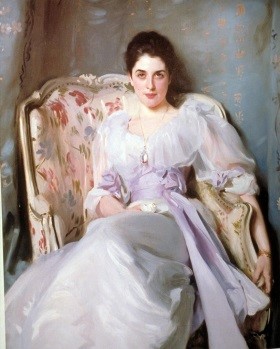 |
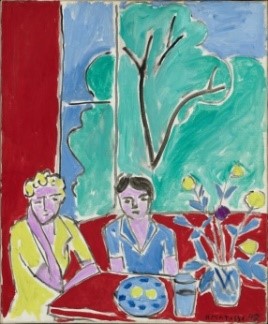 |
| Sargent, John Singer. (ca. 1892-1893). Lady Agnew. Oil on canvas. | Matisse, Henri. (1947). Two Girls, Red and Green Background. Oil on canvas. |
 |
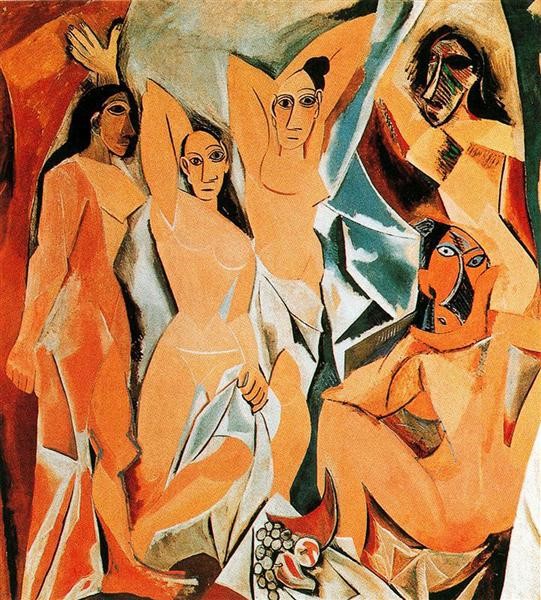 |
| Lucas Cranach the Elder. (1502) Portrait of Dr. Johannes Cuspinian. Tempera on red beech. | Picasso, Pablo. (1907). Les Memoiselles d’Avignon. Oil on canvas. |
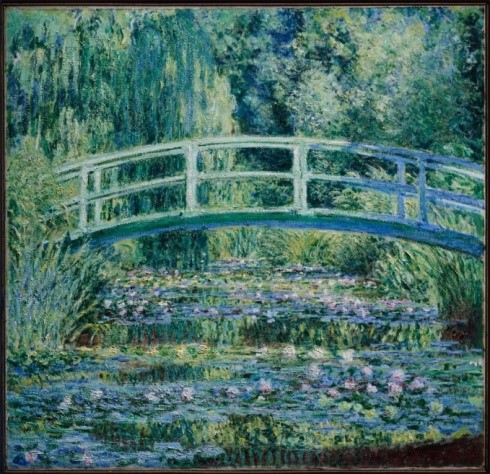 |
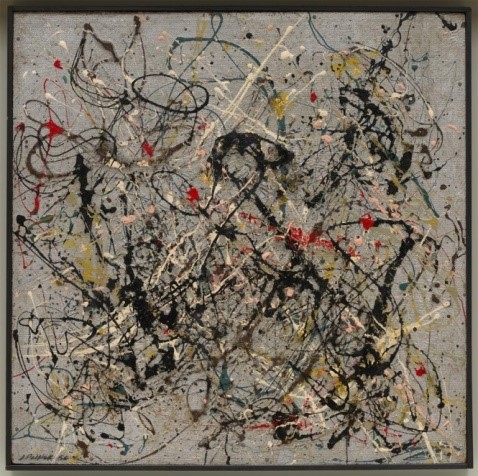 |
| Monet, Claude. (1899). Water Lilies and Japanese Bridge. Oil on canvas. | Pollock, Jackson. (1950). Number 18. Oil and enamel on Masonite. |
Well? What do you think? (Be sure to click on or hover over the thumbnails to see richer reproductions.) And what seems to determine your response? Familiarity? Your understanding? Surprise? A visual puzzle? Our responses to art reflect familiarity and understanding. Consciously or not, we are conditioned to respond comfortably to a Genre, a certain kind of art:
Genre: a particular type of composition marked by expected, conventional features: e.g. Japanese haiku, Chinese landscape painting, Renaissance sonnet
At the movies, do you like rom-coms (romantic comedies)? Urban fantasies? Super hero flicks? ? Film noir? All are cinematic genres with which you are familiar. In the visual arts, the term Genre Painting refers to “paintings or other works depicting scenes from daily life” which have retained their appeal ever since the genre was pioneered by 17th-century Dutch artists. Those Dutch interiors and Still Life compositions are perennially popular because they are familiar in subject matter and in technique. A Genre, is defined by Convention:
Convention: a characteristic feature—subject matter, theme, technique, style—that defines a genre or artistic tradition and is expected and understood by the audience in its context
Artists are guided by convention in composing their work. Audiences approach art with tastes, expectations, and understandings based on convention. Watching a rom com, we know what to expect: an initial meeting between the lovers, usually driven by conflict, affection growing into true love, and an apparently final conflict before the magical resolution.
Of course, unrelieved clichés, excessive conformity to convention can be boring. A rom com that merely lurches from one stock scene to the next will put us to sleep. In great works, an interplay between comforting convention and surprising innovation lights the piece up. Baldick notes that “while some [artistic] works may be ‘unconventional,’ none can be convention less” (Convention).
Conventions grow out of Context: the social, cultural, and historical milieu in which a work of art is composed. But we must consider two contexts:
- The context out of which a work of art is composed
- The context from the audience approaches the work, perhaps many centuries later
In Shakespeare’s day, groundlings paid a pittance to stand in front of the stage watching Hamlet or Much Ado about Nothing. They experienced the plays much differently than we do today.
Contexts vary in their degree of tolerance for convention and for innovation. Since the era of Impressionism , the artistic elite has been valued for originality, innovation, challenges to conventional social values, and individual vision. Yet this was a revolutionary departure from the highly regulated conventional values of the previous Neo-Classical era.
In our day, a widening gap separates the sensibilities of the Fine Arts world from those of the mainstream public. While some folks are drawn to avant garde work, many are put off by wholly unfamiliar, bewildering conventions which can lead to confusion, impatience, dislike, even fear. In which direction do you move when you encounter really challenging ideas or art?
Reading the Arts
stories, and paintings chosen for the class?
Not at all. Nor are you expected to discover hidden codes of meaning that only the instructor can see. You might be concerned about your limited knowledge base. Well, that’s OK. We do ask you to open your minds to fresh experiences, but this course is all about your vision. Your work will be judged for the richness of your observations and reflections.
We will open an array of doors to multiple aspects of the arts. You can choose and deeply engage some that light up for you. We will sample a variety of works and explore some of their features:
Features of an artistic text or image to reflect on:
- Features of the text itself
- The sociocultural context in which the work was produced
- The maker’s life and background
- Genre, conventions and techniques that form the craft of the work
- Structures of meaning
Of course, readings grows richer as we become more knowledgeable. This text will provide an array of information on the Context and techniques that comprise the work. Furthermore, we will approach these works as a reading community, enriching each other’s senses of the works.
In your class readings and writings, draw on the materials we provide and on class collaboration. But when you select a work to focus on in your writing, bear down on your own, close reading. See. Hear. Observe. Pay attention to details. And share the richness of your reading with your reading community.
The Challenge of Encountering the Arts
What about works that make me feel uncomfortable?
What if I really don’t like something?
Always be honest. But sometimes, art is most rewarding when it challenges our comfort zone. We can grow when we bravely engage work that initially puts us off. We will ask you to make a good faith effort to give our selected works a chance to speak to you. We’ll be working on the challenge of engaging art that confuses or put us off. Here are some tips:
Responding to Unfamiliar or Challenging Art
Hold your initial responses loosely
Our initial responses to art—likes and dislikes, understanding and bewilderment—are often conditioned by our sense of the familiar. If we judge too quickly and harshly, we are likely to overlook work we could value and to misread its techniques and themes.
Look for indicators of context
Art’s features and conventions grow from cultural contexts. Obviously, we more easily and comfortably respond to art reflecting our own contexts. We are prone to recoil from work from times and cultures not our own. We can, however, increase our sensitivity to features suggesting another perspective. Always be cautious decoding work from a context foreign to you: might it mean something else in a different context?
Select and consult available information
To illuminate our readings, we will provide limited background information for our works of art. Each week, select a few works that “light up” for you and consult information provided, especially information on unfamiliar works that interest you.
Let the text or image speak for itself
Background information helps. But always let the text of image speak for itself. Be open to its expression of its own values and goals, which may differ from yours or from the conventional genre formulas. Rich readings are based on close, personal observation.
Respond honestly and openly
In our course, we’ll be asking you to give our poems, stories, and images a fair chance to speak to you, especially when illuminated by background information. However, you are not expected to ultimately decide to embrace anything. You might decide that, even after beginning to understand, you are not interested in a certain art form. You don’t gain extra points by liking our materials. We do expect you to read richly and thoughtfully.
The Special Challenge of Poetry
William Butler Yeats (May, 1914) A Coat
Covered with embroideries
Out of old mythologies
From heel to throat;
But the fools caught it,
Wore it in the world’s eyes
As though they’d wrought it.
Song, let them take it
For there’s more enterprise
In walking naked.
Of all the arts, poetry is perhaps the one that causes the most anxiety in the most people. Many readers struggle to read verse, feeling that it often wrenches language out of normative patterns. OK, let’s try to ease the challenge a bit.
First, please try to believe that poems do nothing you don’t do with language. Poetic effects–e.g. Meter and Figures of Speech–are familiar to you if you learn to recognize them. You encounter them in daily speech, songs, and effective oratory. If poetry seems elusive, it is because poets push these effects further and with more cleverness than we are used to.
Second, although the full depth of poetry may seem elusive, that is not because it harbors secret messages only English teachers can see. Too many readers are so busy looking for secret messages that they can’t experience the overt sense and texture of the poem in itself. To enhance your experience of poetry, begin with the immediately available:
Tips on Reading Poetry
- Read aloud, listening for rhythms, patterns. (Click the button above to hear a reading of “Coat.”)
- Recognize the plain sense of the words before looking for hidden meanings.
- Who talks to whom about what? Clearly seeing this dynamic can open many poems.
- Track themes and patterns of meaning that flow from the above.
So … try to relax and let these great artists speak to you. You just might find yourself enjoying them!
References
Blake, W. (1794). The Ancient of Days [Relief etching]. British Museum, London, England.
https://library-artstor-org.ezproxy.bethel.edu/#/asset/LESSING_ART_1039490359
Convention.(2015). [Article]. In C. Baldick (Ed.), The Oxford dictionary of literary terms (4th ed.). Oxford University Press. https://www-oxfordreference-com.ezproxy.bethel.edu/view/10.1093/acref/9780198715443.001.0001/acref-9780198715443-e-251?rskey=VnHfNQ&result=1
Cranach, Lucas the Elder. (c.1502-3). Dr. Johannes Cuspinian. [Painting]. ARTstor https://library-artstor-org.ezproxy.bethel.edu/asset/ARTSTOR_103_41822000873941.
Guthrie, W. (1940). This land is your land [Song]. Woody Guthrie. https://www.woodyguthrie.org/Lyrics/This_Land.htm
Luther, M. (n.d.). A mighty fortress is our God [Song]. Hymnal.net. https://www.hymnal.net/en/hymn/h/886
Matisse, H. (1947). Two girls, red and green background [Painting]. Baltimore Museum of Art, Baltimore, MD. United States.
https://library-artstor-org.ezproxy.bethel.edu/#/asset/ABALTIMOREIG_10313362726
Monet, C. (1899). Water lilies and Japanese bridge [Painting]. Princeton University Art Museum, Princeton, NJ. United States.
https://library-artstor-org.ezproxy.bethel.edu/#/asset/APRINCETONIG_10313684987
Picasso, P. (1907). Les demoiselles d’Avignon [Painting]. Museum of Modern, New York, NY. United States.
https://www.wikiart.org/en/pablo-picasso/the-girls-of-avignon-1907
Pollock, J. (1950). Number 18 [Painting]. Solomon R. Guggenheim Museum, New York, NY. United States.
https://library-artstor-org.ezproxy.bethel.edu/#/asset/AWSS35953_35953_39580984
rutaloot. (2008, November 29). Woody Guthrie — This land is your land [Video]. YouTube. https://youtu.be/wxiMrvDbq3s
Sargent, J. S. (ca. 1892-1893). Lady Agnew [Painting]. National Gallery of Scotland, Edinburgh, Scotland.
https://library-artstor-org.ezproxy.bethel.edu/#/asset/AIC_40038
Yeats, W. B. (May, 1914). A Coat. Poetry, a Magazine of Verse. IV.(11). https://www.poetryfoundation.org/poetrymagazine/poems/12893/a-coat.
a particular type of composition marked by expected, conventional features: e.g. Japanese haiku, Chinese landscape painting, Renaissance sonnet
the social, cultural, and historical milieu in which a work of art is composed and received by an audience. Of course, later audiences will respond from a different point of view and may struggle to understand the original context.
a particular set of values regarding art, taste, and the subjective experience of beauty, ugliness, the sublime, etc. A culture, a school of artists, an individual artist, or an audience can be said to have an aesthetic
French for dark cinema, a term coined by 1960s French film critics to describe films with dark themes and black and white film effects that strongly contrasted light and shadow. Characteristic of German Expressionism (1910s and 20s), Hollywood crime films (1930s and 1940s) and French post-war cinema (1940s and 50s).
paintings that depict domestic scenes and elements of daily life, associated with 17th-century Dutch artists who were commissioned by house-proud patrons. Disdained as a lesser form by 18th and 19th Century academic artists
a genre of painting, drawing, or photograph arranging inanimate objects such as fruit, flowers, pottery or furniture, usually in an interior scene.
a late 19th Century dissident movement among French artists that challenged the conventions of academic art. Impressionists painted quickly, outside in the plein air, seeking to capture with a few deft strokes the colors, lighting and atmosphere of the scene—their subjective impression rather than the “real thing.”
a style of art that emulates a former classical age, generally emphasizing conventional rules, mathematical precision, and reason over passion.
art that is designed to create complex aesthetic experiences rather than to achieve a practical or didactic purpose. Often opposed to Decorative Art or Commercial Design. A conceptual distinction that arose in the 18th Century and remains influential, though subject to increasing criticism
a general term referring to innovative, experimental, potentially subversive artistic movements that challenge the conventions of the day.
a disciplined pattern of sound units throughout the lines of a poem. In English verse, meter is found in the number and pattern of stressed and unstressed syllables in a line. The most common English meter is the iamb: ta-Da-ta-Da-ta-Da-ta-Da//ta-Da-ta-Da-ta-Da.
forms of expression that manipulate normal usage for rhetorical effect. Loosely divided into Tropes (plays of meaning) and Schemes (arrangements and patterns that enhance meaning).

